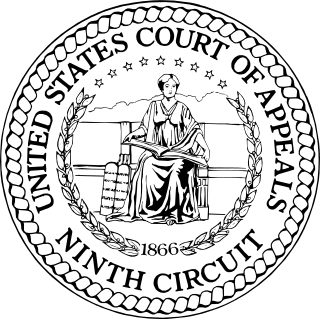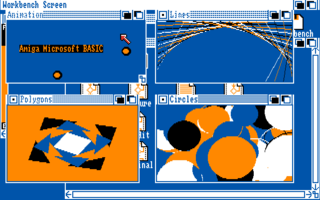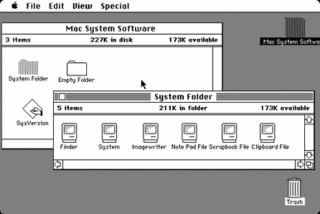
Microsoft Excel is a spreadsheet developed by Microsoft for Windows, macOS, Android and iOS. It features calculation, graphing tools, pivot tables, and a macro programming language called Visual Basic for Applications (VBA). It has been a very widely applied spreadsheet for these platforms, especially since version 5 in 1993, and it has replaced Lotus 1-2-3 as the industry standard for spreadsheets. Excel forms part of the Microsoft Office suite of software.

Microsoft Word is a word processor developed by Microsoft. It was first released on October 25, 1983, under the name Multi-Tool Word for Xenix systems. Subsequent versions were later written for several other platforms including IBM PCs running DOS (1983), Apple Macintosh running the Classic Mac OS (1985), AT&T UNIX PC (1985), Atari ST (1988), OS/2 (1989), Microsoft Windows (1989), SCO Unix (1994), and macOS (2001).

Microsoft Office, or simply Office, is a family of client software, server software, and services developed by Microsoft. It was first announced by Bill Gates on August 1, 1988, at COMDEX in Las Vegas. Initially a marketing term for an office suite, the first version of Office contained Microsoft Word, Microsoft Excel, and Microsoft PowerPoint. Over the years, Office applications have grown substantially closer with shared features such as a common spell checker, OLE data integration and Visual Basic for Applications scripting language. Microsoft also positions Office as a development platform for line-of-business software under the Office Business Applications brand. On July 10, 2012, Softpedia reported that Office was being used by over a billion people worldwide.

ActiveX is a deprecated software framework created by Microsoft that adapts its earlier Component Object Model (COM) and Object Linking and Embedding (OLE) technologies for content downloaded from a network, particularly from the World Wide Web. Microsoft introduced ActiveX in 1996. In principle, ActiveX is not dependent on Microsoft Windows operating systems, but in practice, most ActiveX controls only run on Windows. Most also require the client to be running on an x86-based computer because ActiveX controls contain compiled code.
Microsoft BASIC is the foundation software product of the Microsoft company and evolved into a line of BASIC interpreters adapted for many different microcomputers. It first appeared in 1975 as Altair BASIC, which was the first version of BASIC published by Microsoft as well as the first high-level programming language available for the Altair 8800 microcomputer.
Microsoft Personal Web Server (PWS) is a scaled-down web server software for Windows operating systems. It has fewer features than Microsoft's Internet Information Services (IIS) and its functions have been superseded by IIS and Visual Studio. Microsoft officially supports PWS on Windows 95, Windows 98, Windows 98 SE, and Windows NT 4.0. Prior to the release of Windows 2000, PWS was available as a free download as well as included on the Windows distribution CDs. PWS 4 was the last version and it can be found on the Windows 98 CD and the Windows NT 4.0 Option Pack.
In computer programming, an application framework consists of a software framework used by software developers to implement the standard structure of application software.

Apple Computer, Inc. v. Microsoft Corporation, 35 F.3d 1435, was a copyright infringement lawsuit in which Apple Computer, Inc. sought to prevent Microsoft and Hewlett-Packard from using visual graphical user interface (GUI) elements that were similar to those in Apple's Lisa and Macintosh operating systems. The court ruled that, "Apple cannot get patent-like protection for the idea of a graphical user interface, or the idea of a desktop metaphor [under copyright law]...". In the midst of the Apple v. Microsoft lawsuit, Xerox also sued Apple alleging that Mac's GUI was heavily based on Xerox's. The district court dismissed Xerox's claims without addressing whether Apple's GUI infringed Xerox's. Apple lost all claims in the Microsoft suit except for the ruling that the trash can icon and folder icons from Hewlett-Packard's NewWave windows application were infringing. The lawsuit was filed in 1988 and lasted four years; the decision was affirmed on appeal in 1994, and Apple's appeal to the U.S. Supreme Court was denied.

Internet Explorer for Mac OS X is a proprietary web browser developed by Microsoft for the Macintosh platform to browse web pages. Initial versions were developed from the same code base as Internet Explorer for Windows. Later versions diverged, particularly with the release of version 5, which included the cutting-edge, fault-tolerant and highly standards-compliant Tasman layout engine.

AmigaBASIC is an interpreted BASIC programming language implementation for the Amiga, designed and written by Microsoft. AmigaBASIC shipped with AmigaOS versions 1.1 to 1.3. It succeeded MetaComCo's ABasiC, which was included in AmigaOS 1.0 and 1.1, and was superseded by ARexx, a REXX-style scripting language, from AmigaOS version 2.0 onwards.
Windows code pages are sets of characters or code pages used in Microsoft Windows from the 1980s and 1990s. Windows code pages were gradually superseded when Unicode was implemented in Windows, although they are still supported both within Windows and other platforms, and still apply when Alt code shortcuts are used.

Microsoft Write was a basic word processor included with Windows 1.0 and later, until Windows NT 3.51. Throughout its lifespan it was minimally updated, and is comparable to early versions of MacWrite. Early versions of Write only work with Write (.wri) files, but after Windows 3.0, Write became capable of reading and composing early Word (.doc) documents. With Windows 3.1, Write became OLE capable. In Windows 95, Write was replaced with WordPad; attempting to open Write from the Windows folder will open WordPad instead.
Core OpenGL, or CGL, is Apple Inc.'s Macintosh Quartz windowing system interface to the OS X implementation of the OpenGL specification. CGL is analogous to GLX, which is the X11 interface to OpenGL, as well as WGL, which is the Microsoft Windows interface to OpenGL.
NCSA Telnet is an implementation of the Telnet protocol created at the University of Illinois at Urbana-Champaign National Center for Supercomputing Applications in 1986 and continuously developed until 1995. The initial implementation ran under Mac OS and Microsoft MS-DOS and provided basic DEC VT102 terminal emulation as well as support for multiple simultaneous connections and an internal FTP server. At the time, NCSA Telnet was the first implementation of telnet for the Macintosh or a PC that provided the ability to connect to multiple hosts simultaneously.
Forethought, Inc. was a computer software company, best known as developers of what is now Microsoft PowerPoint.
Macintosh Basic, or MacBASIC, was both a comprehensive programming language and a fully interactive development environment designed by Apple Inc. for the original Macintosh computer. It was developed by original Macintosh team member Donn Denman, with help from fellow Apple programmers Marianne Hsiung, Larry Kenyon, and Bryan Stearns, as part of the original Macintosh development effort starting in late 1981. Andy Hertzfeld said, "A BASIC interpreter would be important, to allow users to write their own programs. We decided we should write it ourselves, instead of relying on a third party, because it was important for the BASIC programs to be able to take advantage of the Macintosh UI, and we didn't trust a third party to 'get it' enough to do it right."

The first version of Microsoft Word was developed by Charles Simonyi and Richard Brodie, former Xerox programmers hired by Bill Gates and Paul Allen in 1981. Both programmers worked on Xerox Bravo, the first WYSIWYG word processor. The first Word version, Word 1.0, was released in October 1983 for Xenix and MS-DOS; it was followed by four very similar versions that were not very successful. The first Windows version was released in 1989, with a slightly improved interface. When Windows 3.0 was released in 1990, Word became a huge commercial success. Word for Windows 1.0 was followed by Word 2.0 in 1991 and Word 6.0 in 1993. Then it was renamed to Word 95 and Word 97, Word 2000 and Word for Office XP. With the release of Word 2003, the numbering was again year-based. Since then, Windows versions include Word 2007, Word 2010, Word 2013, Word 2016, and most recently, Word for Office 365.

| discontinued = yes The Macintosh "System 1" is the first version of Apple Macintosh operating system and the beginning of the classic Mac OS series. It was developed for the Motorola 68000 microprocessor. System 1 was released on January 24, 1984, along with the Macintosh 128K, the first in the Macintosh family of personal computers. It received one update, "System 1.1" on December 29, 1984, before being succeeded by System 2.
The HP CalcPad series were calculators sold by Hewlett-Packard.








